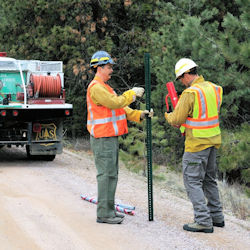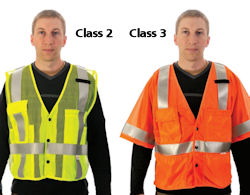High Visibility Safety Apparel and Headwear
ANSI/ISEA 107-2004 specifies four performance classes of apparel or headwear that have different amounts of reflective and background material to enhance pedestrian worker visibility under a variety of work and traffic conditions.
Employers should perform a hazard analysis to decide which performance class is needed based on the work conditions anticipated (e.g., closeness of the work area to traffic, time of day/night, weather, complexity of the background environment, pedestrian worker's task load (need to divert attention to complete other tasks), and traffic speed). This analysis is part of the PPE assessment required by 29 CFR 1910.132(d).
- Class E garments are pants and shorts that have retroreflective and background materials, but may not meet minimum area or placement requirements outlined in the standard. Class E garments are not intended to be worn without a Class 2 or 3 garments
- Class 1 garments provide the minimum amount of required material needed to tell the pedestrian worker apart from the work environment. Class 1 garments are appropriate for activities where pedestrian workers can pay full attention to the approaching traffic, there is enough separation between the pedestrian worker and the vehicle traffic, the work background is not complex, and vehicles and equipment are traveling at speeds less than 25 mph.
- Class 2 garments are appropriate for most hurricane response and recovery work because of the complex work backgrounds, closeness of pedestrian worker to the traffic, the need for the pedestrian worker to divert his/her attention to complete other tasks, or vehicles/equipment are traveling at speeds of 25 miles per hour (mph) or more. Class 2 garments provide better visibility than Class 1 garments by providing additional coverage of the torso.
- Class 3 garments offer the greatest level of visibility in both complex work backgrounds and through a full range of body motion. Class 3 garments should be considered for activities where a pedestrian worker may be exposed to higher vehicle speeds and/or reduced sight distances, the pedestrian worker and vehicle operators have high task loads, or the wearer must be identifiable as a person at least one-quarter mile away.
Knowledge Check Choose the best answer for the question.
5-4. A supervisor is selecting apparel for workers near 30-MPH traffic with complex backgrounds. According to the content, which class should they apply?
You forgot to answer the question!


